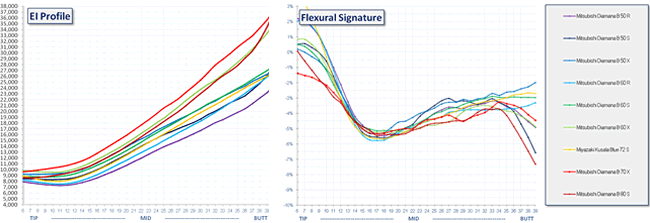EI BEND PROFILE SIGNATURE
By Russ Ryden, A Golf Digest America’s 100 Best Clubfitter
Fit2Score, Dallas Fort Worth, Texas
This term is the best I could come up with for a way to look at shafts that Kim Braly taught me several years ago. You will often see him making presentations about the change of stiffness from point to point on the KBS steel iron shafts. Kim describes his shaft designs as a perfect whip, uniformly loosing stiffness from point to point, butt to tip.
In this illustration of the KBS C Tour shaft the EI profile is shown next to the Bend Profile Signature of the shafts. You can see how the bend profile signature graphic magnifies the bend profile of the shaft. My math savvy friends looked at this and said, oh, you plotted the first derivative, the change in Y with respect to X, or in this case, how much stiffness changes inch by inch, down the shaft.
Don’t assume I understood the math when I created this chart, the idea for this came to me from Kim Braly. He told me in our first meeting, EI is not new, it has been around since the 30’s. He built his first EI instrument by cutting a hole in a desk. Ok, I can see where that would work. He said what you need to focus on is change of stiffness down the shaft.
My signature chart, the first derivative, is just that, how much does the shaft stiffness change from point to point down the shaft. It is actually the inch by inch slope down the shaft. Stiffness is removed, only the change of stiffness is shown. This is, perhaps, the most important metric for shaft fitting. However, I have never seen it outside of my software. But when you look at charts like the one below, you know some shaft designers are looking at it.
The graph on the left shows the EI profiles of the 2013 Mitusbishi Diamana B, the third generation of the Blue Board design. Each shaft has a different stiffness. The illustration on the right charts each of these shafts by showing change of stiffness from point to point. The absolute stiffness is removed and what is left is an understanding of how the model bends. Each of the shafts has essentially the same bend profile despite the fact that they are different weights and flexes.
By comparing shafts with this graphic a club fitter can easily understand the differences between shafts that would otherwise be clouded by weight and flex differences. And by looking at the uniformity of all of the weights and flexes of a model, can quickly see if and when the designer changed the bend profile. This often happens with different weights of a model.
Throughout this site you will see EI bend profile signatures used to highlight and explain differences in designs. Having spent years looking at shafts from this perspective terms like kick point or bend point have come to have little meaning. In fact while doing research for a question I was asked, I found this quote in Total Clubfitting in the 21st Century. My copy was published by Dynacraft in 2007. “Additionally, the effect of bend point and kick point on ball flight now is considered marginal.” Chapter 7, page 92.
We often see shafts with multiple hinges or knees for want of a better word. By knowing the bemd signature of a shaft and getting feedback about feel from the golfer, a good fitter understands how a shaft will feel as well as how it will shape ball flight.



